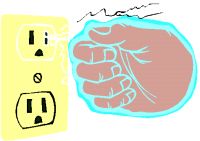| Page 2 |

|
|
1 - Electrical Safety
2 - Page 2 3 - Page 3 4 - Page 4 5 - Page 5 6 - Page 6 |

 |
What Are The Leading Causes of Electrical Accidents?
There are 2 reasons for unsafe acts:
1. We know better but intentionally do something unsafe.
2. We don't know better
Avoid the following unsafe acts:
- Failure to de-energize, lockout & tagout hazards during maintenance, repair or inspections.
- Use of defective and unsafe tools.
- Use of tools or equipment too close to energized parts.
- Not draining off stored energy in capacitors.
- Using 3-wire cord with a 2-wire plug.
- Removing the third prong (ground pin) to make a 3-prong plug fit a 2-prong outlet.
- Overloading outlets with too many appliances.
- Using the attached electrical cord to raise or lower equipment.
- Not verifying power is off when making repair (drilling into a 110 Volt a.c. line can kill).
- Working in an elevated position near overhead lines.
Some common causes of unsafe equipment:
- Loose connections
- Faulty insulation
- Improper grounding (removal of 3rd prong)
- Use of "homemade" extension cords
- Defective parts
- Unguarded live parts--for example:
- Bare conductors or exposed terminals
- Metal parts of equipment may become energeized when connected by cord or plug. Capacitance may cause up to 55% of line voltage to be stored on the casing of metal tools.
Hazardous Environment
Use special precautions when working in potentially hazardous environments and situations. Even an accidental static discharge can cause a fire or explosion in areas where the following are present:
- Flammable vapors, liquids and gasses
- Combustible dusts
- Corrosive atmospheres
- Explosive environments
- Poor housekeeping: blocked electrical boxes, flammable materials stored in equipment rooms, lack of proper hazard signs, excess clutter.
Electrical Fires
Electrical energy can change into other forms of hazardous energy, namely resistive heat and sparks which are the two causes of electrical fires.
  |
Resistive heat is produced when too much current tries to run through a circuit or wire, usually by plugging too many appliances into one wall socket or by using wiring that is too small for the required current, i.e., using an extention cord smaller than that suggested by the operating instructions for the equipment.
Sparks are generated when electricity jumps across a gap or short break in a circuit. Explosion-proof refrigerators, hot plates, thermistors, and other equipment have switches designed to avoid contact with potentially flammable vapors.
In an electrical fire, only use the "C" extinguishers. Never throw water onto an electrical fire.
| << Previous 1 [2] 3 4 5 6 Next >> |

